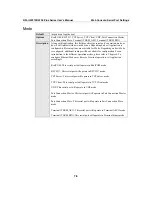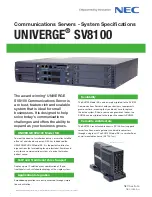
NPort W2150/2250 Plus Series User’s Manual
Web Console: Network Settings
6-16
Encryption
Default
Disable
Options
Disable, WEP, TKIP, AES-CCMP
Description
This field specifies the type of encryption to use during wireless
communication. Different encryption methods are available depending on the
Authentication setting. Also, each encryption method has its own set of
parameters that may also require configuration.
Disable: No encryption is applied to the data during wireless communication.
This option is only available if Authentication is set to Open System.
WEP: Wired Equivalent Privacy (WEP) is only available for Open System and
Shared Key authentication methods. Data is encrypted according to a key. The
NPort supports both 64 and 128-bit keys. This method may deter casual
snooping but is not considered very secure.
TKIP: Temporal Key Integrity Protocol (TKIP) is only available for WPA,
WPA2, WPA-PSK, and WPA2-PSK authentication methods. TKIP is part of a
draft standard from the IEEE 802.11i working group and utilizes the RC4
stream cipher with 128-bit keys for encryption and 64-bit keys for
authentication. TKIP improves on WEP by adding a per-packet key mixing
function to de-correlate the public initialization vectors (IVs) from weak keys.
AES-CCMP: This is a powerful encryption method that is only available for
WPA, WPA2, WPA-PSK, and WPA2-PSK authentication methods. Advanced
Encryption Standard (AES) is the block cipher system used by the Robust
Secure Network (RSN) protocol and is equivalent to the RC4 algorithm used by
WPA. CCMP is the security protocol used by AES, equivalent to TKIP for
WPA. Data undergoes a Message Integrity Check (MIC) using a well-known
and proven technique called Cipher Block Chaining Message Authentication
Code (CBC-MAC). The technique ensures that even a one-bit alteration in a
message produces a dramatically different result. Master keys are not used
directly but are used to derive other keys, each of which expire after a certain
amount of time. Messages are encrypted using a secret 128-bit key and a 128-bit
block of data. The encryption process is complex, but the administrator does not
need to be aware of the intricacies of the computations. The end result is
encryption that is much harder to break than even WPA.
PSK Passphrase
Default
Options
free text (e.g., “This is the WLAN passphrase”)
Description
This field is only available for WPA-PSK and WPA2-PSK authentication
methods. If the NPort’s passphrase does not match the AP’s passphrase, the
connection will be denied. A PSK of sufficient strength—one that uses a mix of
letters, numbers and non-alphanumeric characters—is recommended.
















































